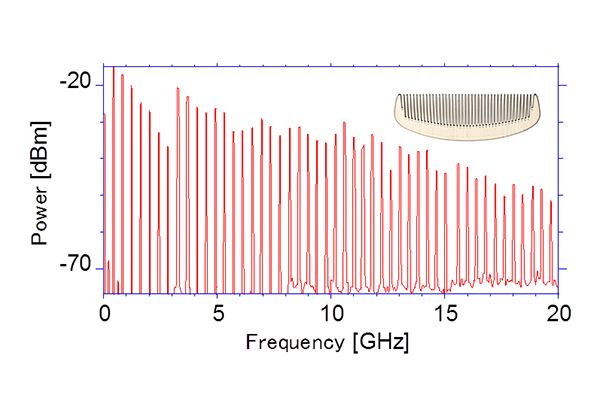HOME > Research Activities > Research Updates >
Developing Diagnostics Using a Frequency Comb
It is thought that Japanese people too from ancient times have greatly enjoyed combs. You might feel strange if you hear that those combs are extremely helpful for investigating plasmas. The comb used here is not the boxwood comb that appears in the children’s song that begins “Kogitsune kon kon.” Rather, this is a comb of frequency, that is, a technology called the frequency comb. The frequency comb generates simultaneously electromagnetic waves of numerous frequencies. The shape of the spectrum of those electromagnetic waves (strength distribution as a function of the frequency) is called a “comb” because this is similar to a comb for combing hair. The frequency comb is a technology that was developed in order to obtain much information from a single transmission and reception. We have applied this technique to high temperature plasma diagnostics.
In a plasma various flows sometimes are generated and become unstable, and a condition appears in which numerous eddies are formed. Such a condition is called turbulence. You will probably have seen photographs and video of the large eddies that are generated on the sun’s surface. Such turbulence appears not only on the surface, it also is generated inside the sun. It may be better to state that the influences from inside the sun appear on the sun’s surface. Similarly, turbulence is being generated inside the Large Helical Device (LHD) plasma, as well. As this turbulence grows in size, it is necessary to investigate and suppress the turbulence because it imposes poor influence upon plasma confinement.
One method for investigating turbulence inside a plasma is the method using the Doppler Effect on electromagnetic waves that are called millimeter waves. When magnetic waves are injected into a plasma, some of the waves are reflected and return from the moving plasma (that is, turbulent). Because the frequency of the magnetic wave that has returned is changing having been influenced by the plasma movement, by analyzing that we can know the strength of the turbulence and the direction of the flow. (The principle of this method is the same as the familiar principle of the radar for rain and cloud observation.) The electromagnetic wave frequency that is reflected changes depending upon the plasma density. The LHD plasma density differs from place to place. For that reason, the position and the movement of the plasma can be known from the incident and reflected frequencies, respectively. To date in the LHD, because we injected the electromagnetic wave of only one frequency, we could obtain information on turbulence from only one location. Thus, this time, we have developed a diagnostic for injecting many electromagnetic wave frequencies simultaneously by using the frequency comb. In this way, we have become able to investigate turbulence information of plasma at various places.
As a result of affixing this diagnostic to the LHD, we have newly discovered physical phenomena about which we had never considered. For example, we discovered the interesting phenomenon in which turbulence is travelling in a plasma in a form of a lump. Further, we have learned that the velocity is close to the speed of sound (340 meters per second), at more than 100 meters per second. Such a phenomenon cannot be known if the inside of the plasma is not being widely observed simultaneously. We learned of this for the first time by using a diagnostic which used the frequency comb. Further, we had predicted theoretically that there was a relationship between the strength of turbulence and the electric field. By using the frequency comb, together with verifying the theory we also were able to obtain experimentally important new knowledge for understanding of plasma physics.
In this way, by utilizing the frequency comb our understanding of plasma turbulence has advanced significantly. At present, because we are improving diagnostics in order to be able to observe plasma in still further detail and in a broader range, we anticipate that more and more new physical phenomena will be discovered in the future.

The frequency spectrum of electromagnetic waves generated by the frequency comb. Each peak of a comb provides information for each place inside the plasma. Because there are numerous peaks, we can collect turbulence data at one time from many places.
